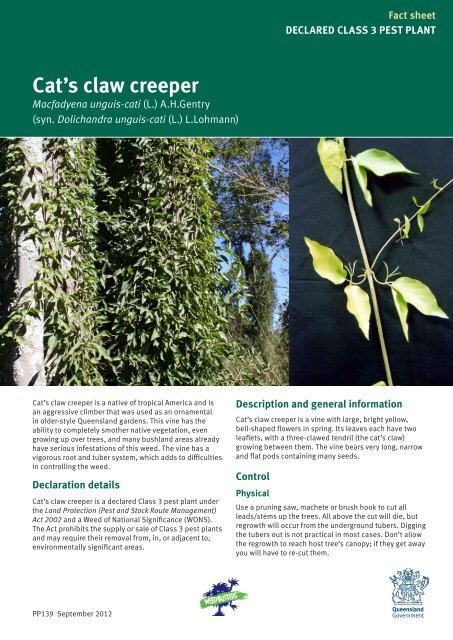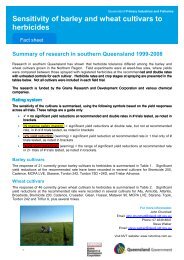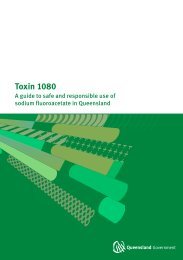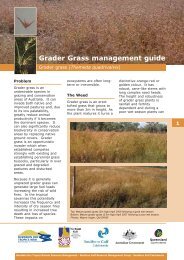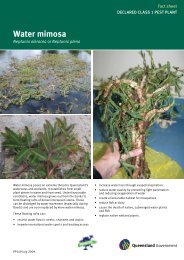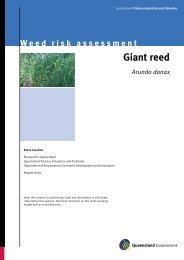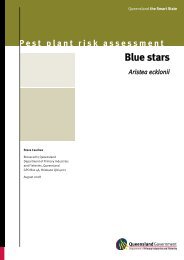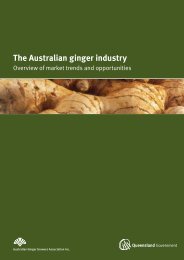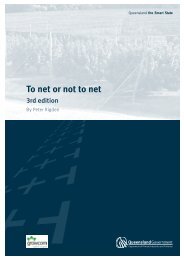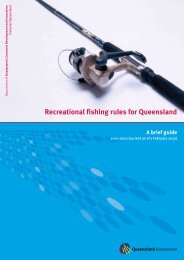You also want an ePaper? Increase the reach of your titles
YUMPU automatically turns print PDFs into web optimized ePapers that Google loves.
Cat’s <strong>claw</strong> <strong>creeper</strong><br />
Macfadyena unguis-cati (L.) A.H.Gentry<br />
(syn. Dolichandra unguis-cati (L.) L.Lohmann)<br />
Cat’s <strong>claw</strong> <strong>creeper</strong> is a native of tropical America and is<br />
an aggressive climber that was used as an ornamental<br />
in older-style Queensland gardens. This vine has the<br />
ability to completely smother native vegetation, even<br />
growing up over trees, and many bushland areas already<br />
have serious infestations of this weed. The vine has a<br />
vigorous root and tuber system, which adds to difficulties<br />
in controlling the weed.<br />
Declaration details<br />
Cat’s <strong>claw</strong> <strong>creeper</strong> is a declared Class 3 pest plant under<br />
the Land Protection (Pest and Stock Route Management)<br />
Act 2002 and a Weed of National Significance (WONS).<br />
The Act prohibits the supply or sale of Class 3 pest plants<br />
and may require their removal from, in, or adjacent to,<br />
environmentally significant areas.<br />
PP139 September 2012<br />
Fact sheet<br />
DECLARED CLASS 3 PEST PLANT<br />
Description and general information<br />
Cat’s <strong>claw</strong> <strong>creeper</strong> is a vine with large, bright yellow,<br />
bell-shaped flowers in spring. Its leaves each have two<br />
leaflets, with a three-<strong>claw</strong>ed tendril (the cat’s <strong>claw</strong>)<br />
growing between them. The vine bears very long, narrow<br />
and flat pods containing many seeds.<br />
Control<br />
Physical<br />
Use a pruning saw, machete or brush hook to cut all<br />
leads/stems up the trees. All above the cut will die, but<br />
regrowth will occur from the underground tubers. Digging<br />
the tubers out is not practical in most cases. Don’t allow<br />
the regrowth to reach host tree’s canopy; if they get away<br />
you will have to re-cut them.
Herbicide<br />
The regrowth is best treated with a foliar spray.<br />
Glyphosate 360 (mixed at a rate of 83 mL to each 1 L of<br />
water) can be applied in a cut stump method. It is best<br />
done in pairs. Cut the lead as close to the ground as<br />
possible and spray/paint on the chemical.<br />
The glyphosate must be applied within 15 seconds of<br />
cutting—while the sap is running—to take the poison<br />
down into the roots and tubers. If not within 15 seconds,<br />
re-cut lower and try again.<br />
Because of the multitude of tubers the herbicide tends<br />
to knock them down one at a time with new regrowth<br />
coming from the next tuber. Be prepared to continue<br />
control over the next five years.<br />
The herbicides listed in the table that follows are<br />
permitted to be used in the listed situations. Before<br />
using any herbicide always read the label carefully.<br />
All herbicides must be applied strictly in accordance<br />
with the directions on the label and the conditions in the<br />
APVMA permit.<br />
Biological control<br />
Cat’s <strong>claw</strong> <strong>creeper</strong> is currently a target for biological<br />
control. The tingid bug Carvalhotingis visenda and the<br />
moth Hypocosmia pyrochroma have been released. The<br />
tingid is widely established in majority of release sites<br />
and cause visible effects in some areas. A leaf-mining<br />
jewel beetle Hylaeogena jureceki has been approved<br />
for field release, and field releases will commence in<br />
October 2012.<br />
Further information<br />
Further information is available from your local<br />
government office, or by contacting Biosecurity<br />
Queensland (call 13 25 23 or visit our website at<br />
www.biosecurity.qld.gov.au).<br />
2 Cat’s <strong>claw</strong> <strong>creeper</strong> Macfadyena unguis-cati (L.) A.H.Gentry (syn. Dolichandra unguis-cati (L.) L.Lohmann)
Table 1 Herbicides permitted under APVMA PER11463 and PER10533 for the control of cat’s <strong>claw</strong> <strong>creeper</strong><br />
Situation Herbicide Rate Comments<br />
Pasture, non-crop<br />
situation (PERMIT<br />
PER10533)<br />
Non-agricultural areas,<br />
bushland, forests,<br />
wetlands, coastal and<br />
adjacent areas permit<br />
PER11463<br />
360 g/L<br />
glyphosate<br />
500 g/L<br />
dicamba<br />
200 g/L<br />
fluroxypyr<br />
10 mL/L water Foliar application<br />
83 mL/L water Cut stump<br />
Ensure vines are actively growing at time of treatment and not under<br />
stress of drought, waterlogging or cold.<br />
(0–2 m height) High-volume (knapsack or handgun) spray to wet<br />
foliage, ensuring complete coverage over top growing terminals.<br />
Ensure vines are actively growing at time of treatment and not under<br />
stress of drought, waterlogging or cold.<br />
Cut vine close to ground and immediately wet stump surface<br />
thoroughly using splatter gun, spray, swab or brush. Remove any<br />
branches on the stump and treat any cut surface.<br />
4 mL/L water Foliar application<br />
33 mL/L water Cut stump<br />
35 mL/L<br />
diesel/<br />
kerosene<br />
Ensure vines are actively growing at time of treatment and not under<br />
stress of drought, waterlogging or cold.<br />
(0–2 m height) High-volume (knapsack or handgun) spray to wet<br />
foliage, ensuring complete coverage over top growing terminals.<br />
Ensure vines are actively growing at time of treatment and not under<br />
stress of drought, waterlogging or cold.<br />
Cut vine close to ground and immediately wet stump surface<br />
thoroughly using splatter gun, spray, swab or brush. Remove any<br />
branches on the stump and treat any cut surface.<br />
Basal bark spray<br />
Read the label carefully before use and always use the herbicide in accordance with the directions on the label.<br />
Persons who wish to prepare for use and/or use products for the purposes specified in APVMA permits PER11463<br />
or PER10533 must read, or have read to them, the details and conditions of the permit. APVMA permit PER11463<br />
expires on 30 June 2014 and PER10533 expires on 30 June 2013. Both are available from the APVMA website at<br />
www.apvma.gov.au<br />
Fact sheets are available from Department of Agriculture, Fisheries and Forestry (DAFF) service centres and our Customer Service Centre (telephone 13 25 23).<br />
Check our website at www.biosecurity.qld.gov.au to ensure you have the latest version of this fact sheet. The control methods referred to in this fact sheet should<br />
be used in accordance with the restrictions (federal and state legislation, and local government laws) directly or indirectly related to each control method. These<br />
restrictions may prevent the use of one or more of the methods referred to, depending on individual circumstances. While every care is taken to ensure the accuracy<br />
of this information, DAFF does not invite reliance upon it, nor accept responsibility for any loss or damage caused by actions based on it.<br />
© The State of Queensland, 2012.<br />
CS1984 9/12


